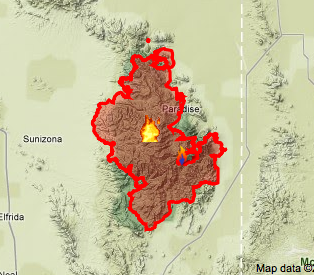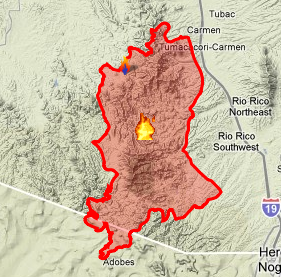지도 / 봉쇄 % 업데이트: 16 6월
7 월에 접근하면 나는 Lepidopterists의 태평양 연안 회의에 기대되는’ 사회. 올해는 프레스콧 애리조나에서 개최됩니다, 약 2 북쪽으로 피닉스의 시간. And as of this moment it is one of the few places in Arizona 아니 on fire. I’m sure you have all heard of the massive fires right now, but here is an update from a slightly biological standpoint. Most importantly we should all be thankful for the firefighters risking their lives to battle these wildfires.
For some reason I couldn’t link to the interactive maps directly from the InciWeb site, but please follow the links to explore further. While there are good interactive maps of these fires on Google Maps, they are a few days old. Below are screen-captures of maps less than 12 hours old.
화재 1: The biggest one, The Wallow Fire 이다 20% 29% contained, human caused and has been burning for over 15 일. I had been hoping to go collecting around the town of Greer and Alpine, but both have fire quickly encroaching. The White Mountains region of Arizona is a fascinating blend zone between southern desert species and Rocky Mountain ones – the rare moth I was hoping to find here, Alexicles aspersa, will likely evade me yet again this year.
화재 2: Horseshoe 2 화재. 60% contained, human caused, burning for over 37 일. This fire has consumed nearly the entirety of the Chiricahua Mountains, save for the famous Southwestern Research Station. The news report is a few weeks old, but thankfully I doubt anything has happened to the station since that would have made headlines quickly (at least in the biology community). Aside from notable endangered species (2), the upper-most peaks of this range have recently revealed handfuls of impressively large and beautiful new species of Lepidoptera: 리소판 리애, Chiricahua lichenaria (new genus, new species), Eupithica 종, Grammia allectans (old sp, but only known in this region) – amongst other yet to be named ones! It is hypothesized that since only the highest peaks are revealing these impressive species that they are attenuated populations from the adjacent mountains in northern Mexico. Since every high peak has now burned, it is likely that some of these may now be extirpated from the US.
화재 3: Murphy Complex Fire. 90% contained, human caused, burning for 15 일. This fire has burned some of the most famous collecting sites in all of Arizona – 포함 Pena Blanca, Sycamore Canyon and California Gulch. The birders know Cal Gulch because it is one of the only US locations for the five-striped sparrow 과 elegant trogon, which may not be so happy now.
Without getting too deep into the politics and controversy surrounding wildfire, for the most part nature has evolved to cope with these events. While current management policies may be flawed, there will be a fascinating succession of species over the coming decades. Each location will have burned differently and will experience different fluctuations of species as plants recolonize. I am most concerned about the Chiricahua fire since all of the high elevation areas have burned, leaving zero areas of similar habitat for recolonization events. Hopefully many of these newer species range into Mexico, but the possibility of losing an unknown endemic still exists. Alternatively, these fires could be a positive event and lead to stronger populations of some species or even colonization by other unknown Mexican animals. More likely than not each species will respond different and it will be fascinating to monitor the progress over the long recovery.




Good to hear someone raise the topic of habitat change and possible new species in the Chiricahua Mountains. While it may not be pretty, habitat reorganization due to fire does not equate to the elimination of habitat.